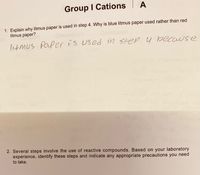
Chemistry
10th Edition
ISBN: 9781305957404
Author: Steven S. Zumdahl, Susan A. Zumdahl, Donald J. DeCoste
Publisher: Cengage Learning
expand_more
expand_more
format_list_bulleted
Concept explainers
Question

Transcribed Image Text:Group I Cations
A
1. Explain why litmus paper is used in step 4. Why is blue litmus paper used rather than red
litmus paper?
litmus Paper is used in Step y because
2. Several steps involve the use of reactive compounds. Based on your laboratory
experience, identify these steps and indicate any appropriate precautions you need
to take.
![Qualitative Analysis
Step 2. The solubility of lead is sufficiently high that at low lead concentrations, all of the
in addition, the solubility of lead increases about threefold in hot water compared to room tem
perature water; thus, a significant amount of lead can be solubilized from the mixture of AgCl,
H92CI2, and P6CI2 by treating the mixture with hot water. Therefore, centrifuging the resulting
solution leaves only a solution of lead (if lead is present).
Step 3. The presence of lead can be confirmed or eliminated by the addition of chromate to
form the bright yellow solid PbCrO. (Equation 8). You may recognize this color because lead
chromate is often the pigment in the yellow paint used to paint yellow lines on highways.
Equation (8)
Pb2*(aq) + Cro?-(aq) PbCrO4(s) Ksp = 1.8 × 10-14
Step 4. The addition of aqueous ammonia results in the formation of the complex ion
[Ag(NH3)21*, solubilizing the silver, but also in the disproportionation of the Hg* (i.e., Hg2") into
Hg° metal and Hg2*, which forms the solid H9NH,CI under these conditions (Equations 9, 10,
and 11).
Equation (9)
Hg2*(aq) :
= Hg°(s) + Hg2*(aq)
Equation (10)
Hg2*(aq) + CI(aq) + 2 NH3(aq) = H9NH2CI(s) + NHẬ(aq)
Equation (11)
AgCl(s) + 2 NH3(aq) =
2[Ag(NH3)2]*(aq) + CI¯(aq)
Finally, to confirm the presence of silver, the addition of acid results in the protonation of the
ammonia to the ammonium cation, resulting in the reprecipitation of silver chloride (Equation 12).
Equation (12)
[Ag(NH3)2]*(aq) + 2 H*(aq) + CI"(aq)=AgCI(s) + 2[NH4J*(aq)](https://content.bartleby.com/qna-images/question/6ce781c6-ca6f-48b8-a006-1cccfb769dcf/3aca54e7-6156-4f9b-8688-adf875196d86/6av4xz_thumbnail.jpeg)
Transcribed Image Text:Qualitative Analysis
Step 2. The solubility of lead is sufficiently high that at low lead concentrations, all of the
in addition, the solubility of lead increases about threefold in hot water compared to room tem
perature water; thus, a significant amount of lead can be solubilized from the mixture of AgCl,
H92CI2, and P6CI2 by treating the mixture with hot water. Therefore, centrifuging the resulting
solution leaves only a solution of lead (if lead is present).
Step 3. The presence of lead can be confirmed or eliminated by the addition of chromate to
form the bright yellow solid PbCrO. (Equation 8). You may recognize this color because lead
chromate is often the pigment in the yellow paint used to paint yellow lines on highways.
Equation (8)
Pb2*(aq) + Cro?-(aq) PbCrO4(s) Ksp = 1.8 × 10-14
Step 4. The addition of aqueous ammonia results in the formation of the complex ion
[Ag(NH3)21*, solubilizing the silver, but also in the disproportionation of the Hg* (i.e., Hg2") into
Hg° metal and Hg2*, which forms the solid H9NH,CI under these conditions (Equations 9, 10,
and 11).
Equation (9)
Hg2*(aq) :
= Hg°(s) + Hg2*(aq)
Equation (10)
Hg2*(aq) + CI(aq) + 2 NH3(aq) = H9NH2CI(s) + NHẬ(aq)
Equation (11)
AgCl(s) + 2 NH3(aq) =
2[Ag(NH3)2]*(aq) + CI¯(aq)
Finally, to confirm the presence of silver, the addition of acid results in the protonation of the
ammonia to the ammonium cation, resulting in the reprecipitation of silver chloride (Equation 12).
Equation (12)
[Ag(NH3)2]*(aq) + 2 H*(aq) + CI"(aq)=AgCI(s) + 2[NH4J*(aq)
Expert Solution
This question has been solved!
Explore an expertly crafted, step-by-step solution for a thorough understanding of key concepts.
This is a popular solution
Trending nowThis is a popular solution!
Step by stepSolved in 2 steps

Knowledge Booster
Learn more about
Need a deep-dive on the concept behind this application? Look no further. Learn more about this topic, chemistry and related others by exploring similar questions and additional content below.Similar questions
- What is the importance of bunsen burner? Explain. What is the purpose of bunsen burner? Explain. Why we should use bunsen burner in the laboratory? What are the safety warning and PPE during bunsen burner experiment?arrow_forwardHydrolysis of KCN will lead to an acidic solution. A. True B. Falsearrow_forwardWHAT IS hABERS process?arrow_forward
- please solve question 15arrow_forwardHow would the following chemicals react during a permanganate test?arrow_forwardWhat are the structural requirement of a good fluorophore? select one or more than one a. contains flouride b. combined aromatic groups c. molecules with several π bonds d. contain halogen e. long carbon chainarrow_forward
arrow_back_ios
arrow_forward_ios
Recommended textbooks for you
 ChemistryChemistryISBN:9781305957404Author:Steven S. Zumdahl, Susan A. Zumdahl, Donald J. DeCostePublisher:Cengage Learning
ChemistryChemistryISBN:9781305957404Author:Steven S. Zumdahl, Susan A. Zumdahl, Donald J. DeCostePublisher:Cengage Learning ChemistryChemistryISBN:9781259911156Author:Raymond Chang Dr., Jason Overby ProfessorPublisher:McGraw-Hill Education
ChemistryChemistryISBN:9781259911156Author:Raymond Chang Dr., Jason Overby ProfessorPublisher:McGraw-Hill Education Principles of Instrumental AnalysisChemistryISBN:9781305577213Author:Douglas A. Skoog, F. James Holler, Stanley R. CrouchPublisher:Cengage Learning
Principles of Instrumental AnalysisChemistryISBN:9781305577213Author:Douglas A. Skoog, F. James Holler, Stanley R. CrouchPublisher:Cengage Learning Organic ChemistryChemistryISBN:9780078021558Author:Janice Gorzynski Smith Dr.Publisher:McGraw-Hill Education
Organic ChemistryChemistryISBN:9780078021558Author:Janice Gorzynski Smith Dr.Publisher:McGraw-Hill Education Chemistry: Principles and ReactionsChemistryISBN:9781305079373Author:William L. Masterton, Cecile N. HurleyPublisher:Cengage Learning
Chemistry: Principles and ReactionsChemistryISBN:9781305079373Author:William L. Masterton, Cecile N. HurleyPublisher:Cengage Learning Elementary Principles of Chemical Processes, Bind...ChemistryISBN:9781118431221Author:Richard M. Felder, Ronald W. Rousseau, Lisa G. BullardPublisher:WILEY
Elementary Principles of Chemical Processes, Bind...ChemistryISBN:9781118431221Author:Richard M. Felder, Ronald W. Rousseau, Lisa G. BullardPublisher:WILEY

Chemistry
Chemistry
ISBN:9781305957404
Author:Steven S. Zumdahl, Susan A. Zumdahl, Donald J. DeCoste
Publisher:Cengage Learning

Chemistry
Chemistry
ISBN:9781259911156
Author:Raymond Chang Dr., Jason Overby Professor
Publisher:McGraw-Hill Education

Principles of Instrumental Analysis
Chemistry
ISBN:9781305577213
Author:Douglas A. Skoog, F. James Holler, Stanley R. Crouch
Publisher:Cengage Learning

Organic Chemistry
Chemistry
ISBN:9780078021558
Author:Janice Gorzynski Smith Dr.
Publisher:McGraw-Hill Education

Chemistry: Principles and Reactions
Chemistry
ISBN:9781305079373
Author:William L. Masterton, Cecile N. Hurley
Publisher:Cengage Learning

Elementary Principles of Chemical Processes, Bind...
Chemistry
ISBN:9781118431221
Author:Richard M. Felder, Ronald W. Rousseau, Lisa G. Bullard
Publisher:WILEY